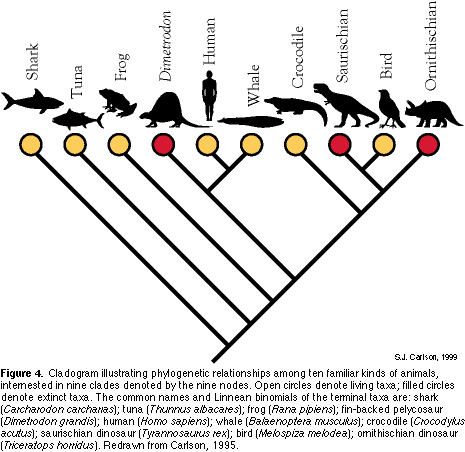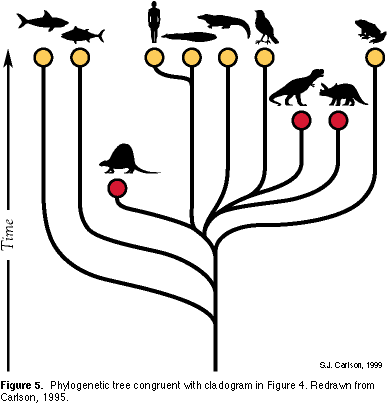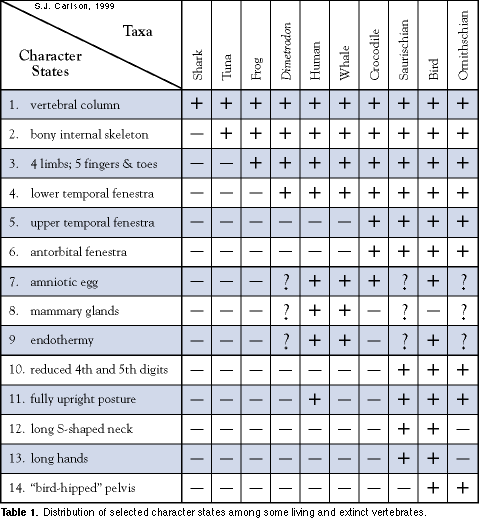Tracking the Course of Evolution
EVOLUTION AND SYSTEMATICS (cont.)
NOTE: This is page 2 of a five-page document.
SYSTEMATICS AND PHYLOGENY
Continued speciation will generate groups of closely related species. A clade is a group of species that includes an ancestral species and all of its descendants (Figures 3, 4). Clades (also called monophyletic groups), like species, are formed by the process of descent with modification. A phylogeny is a pattern of common ancestry reflecting this evolutionary process. We call our own "family phylogeny" a family tree (Figure 2) or a genealogy; the terms all refer to the same type of pattern generated at different scales by the evolutionary process of common descent.

Phylogenetic Inference
Because species and clades originate over evolutionary time scales, by the splitting or branching process inherent in reproductive isolation (Figure 3.1), we cannot observe their origination directly. Instead, we must infer the relative timing of origination of species by comparing features that they possess. How do we decide which species are closest? And especially how do we decide which species branched off from which? We use special methods of phylogenetic inference, developed over the last several decades, to compare features present in a given group of species to allow us to figure out how they are related to one another. These methods are based on the same simple principle that we use unconsciously to guess at human family relationships. Closely related individuals tend to share a larger number of similar features than do distantly related individuals, as a result of their shared common ancestry.
RETURN TO TOP
 Is a whale more closely related to a human or a shark? Even though whales and sharks both share certain features of overall body form, by following phylogenetic methods of observation and comparison (discussed in more detail below), we conclude that whales and humans actually have many more detailed features in common (see Figure 7) than do whales and sharks. This can be explained by the fact that whales share a more recent common ancestry with humans (Figure 4) than they do with sharks. We predict that their closer relationship means that they share more features in common, and the evidence supports this prediction. Similarities between whales and sharks are largely superficial and result from their common aquatic habitat, not from their descent from a common ancestor. Phylogenetic systematics is the name of the field of study in which genealogical relationships among species and clades are discovered. Systematists practice systematic methods of reconstructing phylogenies in order to understand the pattern and process of evolution. Is a whale more closely related to a human or a shark? Even though whales and sharks both share certain features of overall body form, by following phylogenetic methods of observation and comparison (discussed in more detail below), we conclude that whales and humans actually have many more detailed features in common (see Figure 7) than do whales and sharks. This can be explained by the fact that whales share a more recent common ancestry with humans (Figure 4) than they do with sharks. We predict that their closer relationship means that they share more features in common, and the evidence supports this prediction. Similarities between whales and sharks are largely superficial and result from their common aquatic habitat, not from their descent from a common ancestor. Phylogenetic systematics is the name of the field of study in which genealogical relationships among species and clades are discovered. Systematists practice systematic methods of reconstructing phylogenies in order to understand the pattern and process of evolution.
 Cladograms and
Cladograms and
Phylogenetic Trees
Phylogenetic patterns generated from branching processes may be represented in at least two different ways: cladograms and phylogenetic trees. Cladograms are branching diagrams that illustrate patterns of phylogenetic relationships. The pattern of branching itself is the focus of a cladogram; the relative lengths of branches in cladograms have no special significance (Figure 4). Time is included in cladograms only in a relative sense, in the internested structure of the cladogram itself. For example (Figure 4), we see that sharks originated before whales, but cannot tell from the cladogram how long before. Phylogenetic trees are branching diagrams that illustrate both branching patterns and time; branch lengths have meaning in the sense that longer branches imply longer periods of time (Figure 5). We can think of both cladograms and trees as phylogenetic maps. Both express hypotheses about a phylogeny — a pattern of evolution.
RETURN TO TOP
 Cladograms are reconstructed by comparing the distribution of characters among species. Characters are inherited attributes of organisms; they may be morphological, genetic, developmental, behavioral, physiological, biochemical, and so forth. Hair color, leg length, or gene sequence, for example, are characters of organisms that vary. The variation can be characterized by counting or measuring or describing it. Character states distinguish different variations of a given character. Red, blonde, or black are different states of the character "hair color." Cladograms are reconstructed by comparing the distribution of characters among species. Characters are inherited attributes of organisms; they may be morphological, genetic, developmental, behavioral, physiological, biochemical, and so forth. Hair color, leg length, or gene sequence, for example, are characters of organisms that vary. The variation can be characterized by counting or measuring or describing it. Character states distinguish different variations of a given character. Red, blonde, or black are different states of the character "hair color."
Examining Characters
There are two types of characters in phylogenetic inference — homologous characters "tell the truth" about phylogeny, and homoplastic characters are deceptive about phylogenetic relationships. Homologous characters share common ancestry (Figure 4 and Table 1), and for this reason they are useful in reconstructing phylogeny. They are often, but not always, similar to one another in appearance. Homology of two states can be tested by comparing the development and location of the features on organisms. Hair, for example, develops in the same manner, from the same kind of cells in the skin in all mammals. Hair is homologous in cows, bats, humans, and all other mammals.

RETURN TO TOP
Homoplastic (analogous) characters may also be similar in appearance, but have actually evolved from different ancestors. Homoplastic characters can distort patterns of relationship indicated by homologous characters because they are often in conflict with them. Octopus eyes and human eyes are homoplastic; they develop very differently and have evolved independently in two remotely related groups of animals. Body form in whales and fishes is homoplastic and relates to their aquatic mode of life (Figure 4). Wings in birds and bats have evolved separately in each group; these features are homoplastic as wings. However, they are homologous as forearms, because they evolved in each case from the front limbs.
 Characters change from one state to another through the process of evolution. The initial (old) state is said to be ancestral (or plesiomorphic); the new or novel state is derived (or apomorphic) relative to the ancestral state. For example, brain to body size ratios increased in human evolution. Relatively smaller brains are ancestral, relatively larger brains are derived. Closely related organisms share derived features, such as feathers shared by birds. Characters shared through common ancestry (homologues) and derived relative to a former state are called shared derived characters or synapomorphies. Species and clades are defined by these new features because they are more informative than shared ancestral characters (symplesiomorphies). Fully upright posture, walking on two legs, the development of language and culture, and perhaps the ability to use tools distinguish us from both of our closest living relatives, the gorillas and chimps. Characters change from one state to another through the process of evolution. The initial (old) state is said to be ancestral (or plesiomorphic); the new or novel state is derived (or apomorphic) relative to the ancestral state. For example, brain to body size ratios increased in human evolution. Relatively smaller brains are ancestral, relatively larger brains are derived. Closely related organisms share derived features, such as feathers shared by birds. Characters shared through common ancestry (homologues) and derived relative to a former state are called shared derived characters or synapomorphies. Species and clades are defined by these new features because they are more informative than shared ancestral characters (symplesiomorphies). Fully upright posture, walking on two legs, the development of language and culture, and perhaps the ability to use tools distinguish us from both of our closest living relatives, the gorillas and chimps.
 Suppose we tried to define human beings by the possession of hair. Hair is homologous among all mammals, shared by common ancestry, so it is not a deceptive, homoplastic character that we would automatically avoid using. However, hair is a shared ancestral character for humans. Because it is also shared by many non-human mammals, it doesn't help to distinguish humans from other mammalian species, and is a pretty useless diagnostic character. Suppose we tried to define human beings by the possession of hair. Hair is homologous among all mammals, shared by common ancestry, so it is not a deceptive, homoplastic character that we would automatically avoid using. However, hair is a shared ancestral character for humans. Because it is also shared by many non-human mammals, it doesn't help to distinguish humans from other mammalian species, and is a pretty useless diagnostic character.
Character Polarity
The direction of character change in evolution, from ancestral to derived, is referred to as character polarity. It is not always obvious which character states are derived and which ancestral. Some criteria for determining the direction of character change in evolution must be established. Ancestral and derived states are always identified as such by comparison to a frame of reference (Figure 4, Table 1). Of several possible character states (e.g., hair present, hair absent), the ancestral state is the one present in a closely related species outside the group of interest (outgroup criterion), or the one appearing lower in the stratigraphic record (paleontological criterion), or earlier in development (ontogenetic criterion). Because ancestral and derived states are determined relative to some reference frame, their status changes if the frame of reference changes. Hair is derived for mammals (relative to other [non-mammalian] vertebrates), but ancestral for humans, because the closest relatives to humans, gorillas and chimps, also have hair. Consider whales, which have very minimal hair. Does their apparent lack of hair mean that whales are not mammals? No. Because of many other shared derived characters of mammals that whales possess (for example, giving birth to live young and nursing their young), we conclude that whales are mammals that no longer need much hair for their fully aquatic mode of life. Loss of hair is thus a derived feature for whales, among the mammals.
 To summarize, all living things are related to each other, more closely or more distantly. This relative pattern of relationships can be expressed in a vast, nested hierarchy — the hierarchy of life — represented in a series of internested cladograms. The possession of certain features (homologues) can help locate the position of an individual in the hierarchy of life. Closely related individuals tend to share a larger number of similar features than do distantly related individuals as a result of their shared common ancestry. Establishing the pattern of character distribution among individuals and among species and higher taxa can therefore reflect and reveal the process of common descent with modification — the process of evolution. To summarize, all living things are related to each other, more closely or more distantly. This relative pattern of relationships can be expressed in a vast, nested hierarchy — the hierarchy of life — represented in a series of internested cladograms. The possession of certain features (homologues) can help locate the position of an individual in the hierarchy of life. Closely related individuals tend to share a larger number of similar features than do distantly related individuals as a result of their shared common ancestry. Establishing the pattern of character distribution among individuals and among species and higher taxa can therefore reflect and reveal the process of common descent with modification — the process of evolution.
BACK to page 1
CONTINUE to page 3
|


